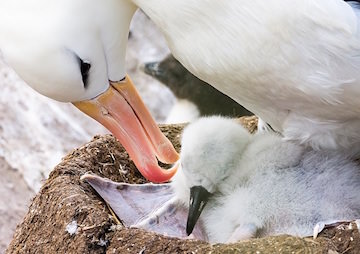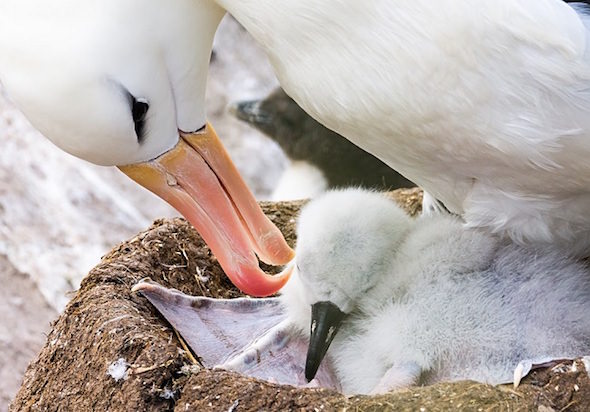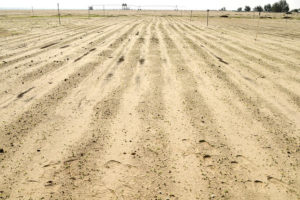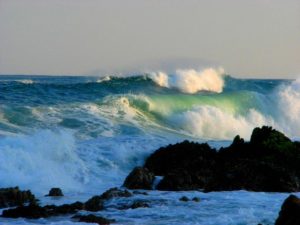Loss of Seabirds Highlights Double Danger for Species
Scientists say increasing human impacts on habitat are combining with climate change to put serious survival stresses on species and ecosystems.
By Tim Radford, Climate News Network

The population size of seabirds such as albatross is one measure of ocean health. (David Cook via Flickr)
This Creative Commons-licensed piece first appeared at Climate News Network.
LONDON — A grim decline of seabird populations, native trout being driven out because of the warming of Canadian lakes, and the destruction of an entire ecosystem in the US are all highlighted in new research.
The combined evidence shows that climate change offers a part-explanation for all three observations — but human pressure and human destruction of habitat are mostly to blame.
The world’s seabirds — such as terns, albatrosses, cormorants, gulls and petrels — are quietly flying away to nowhere.
In the lakes of Ontario, the warm water-loving bass is beginning to drive out the native trout.
And in the Great Basin of the United States, a whole ecosystem has become impoverished as the flow of energy through the vegetation and its animal populations has dwindled.
Biologists’ warning
Marine biologists have for decades been warning about the state of the world’s oceans, and seabird populations are one measure of ocean health.
Michelle Paleczny, a researcher at the University of British Columbia Fisheries Centre in Vancouver, and colleagues report in the Public Library of Science journal PLOS One that they compiled a global database of seabird population records and then examined the population trends in colonies monitored between 1950 and 2010.
This monitored population added up to about 19% of the global count of seabirds and showed a grim decline. Overall, seabird counts had fallen by more than 69% — which adds up to 230 million birds — in the past six decades, and those seabirds that ranged the widest seemed to fare the worst.
In some cases, global warming as a consequence of the build-up of carbon dioxide levels in the atmosphere because of fossil fuel burning has altered the water chemistry and local climate and food supplies for seabird colonies.
But the greatest damage followed other human activity: devastation by fishing fleets, plastic and oil pollution, the introduction of new predators, and entanglement in fishing gear all took their toll. Albatross species in particular are killed in huge numbers each year as they become snagged in fishing fleet long lines.
“Our work demonstrates the strong need for increased seabird conservation effort internationally,” Paleczny says. “Loss of seabirds causes a variety of impacts in coastal and marine ecosystems.”
“We are just beginning to understand
the variety of indirect consequences
related to climate change.”
Sport fishing in Ontario contributes an estimated $2bn to the local economy, but fisheries officers and scientists may not be able to conserve the brook trout the anglers cast for.
That’s because the fresh waters are warming, and bass — which prefer warm water — are migrating north to out-compete the local population.
Karen Alofs, a researcher in the Department of Ecology and Evolutionary Biology at the University of Toronto, and others looked at data for 30 fish species from 1,500 lakes — the province has 250,000 lakes altogether – to map the northward advance of the bass in the last 30 years.
Such research, published in the Proceedings of the Royal Society B, is intended to help conservators by offering a guide to how local ecosystems could change.
“It’s important to anticipate how climate change will shape future fish communities, and ultimately fishing opportunities and the sustainability of aquatic ecosystems,” Alofs says. “We are just beginning to understand the variety of indirect consequences related to climate change.”
Vast watershed
But although change in that vast watershed of western US and Mexico called the Great Basin is contemporaneous with the Industrial Revolution, and the rise of carbon dioxide levels in the atmosphere, other human activities may have triggered the dramatic alteration.
Rebecca Terry, assistant professor in the Department of Integrative Ecology at Oregon State University, and a colleague report in the Proceedings of the National Academy of Sciences that they used fossilised owl pellets preserved in a cave to measure changes in the ecosystem over a 13,000 year span.
The pellets are regurgitated by owls after they feed, and contain fragments of bone and other tissue from small mammals caught through the millennia. So each stony little segment of dried vomit is a database of local conditions at the time of digestion and regurgitation.
The message of the ancient bones, teeth and hair is that the basin was once a huge reservoir of living, flowing energy. At the end of the Ice Age, forests and sagebrush steppe gave way to desert shrubland, but the flow of energy — from sunlight to foliage to herbivore and carnivore — remained more or less constant.
And then an invasive grass that arrived with western settlers began to change the picture; mammal size dwindled, and the region became ecologically poorer.
“They show a dramatic breakdown in ecosystem behaviour since the late 1800s, in a way that doesn’t parallel what happened when major climatic warming took place at the end of the last Ice Age,” Dr Terry says.
“The current state is driven by human impacts to habitat, and these impacts have been a stronger force in shaping the mammal community over the last century than just climate change.”
Your support matters…Independent journalism is under threat and overshadowed by heavily funded mainstream media.
You can help level the playing field. Become a member.
Your tax-deductible contribution keeps us digging beneath the headlines to give you thought-provoking, investigative reporting and analysis that unearths what's really happening- without compromise.
Give today to support our courageous, independent journalists.






You need to be a supporter to comment.
There are currently no responses to this article.
Be the first to respond.